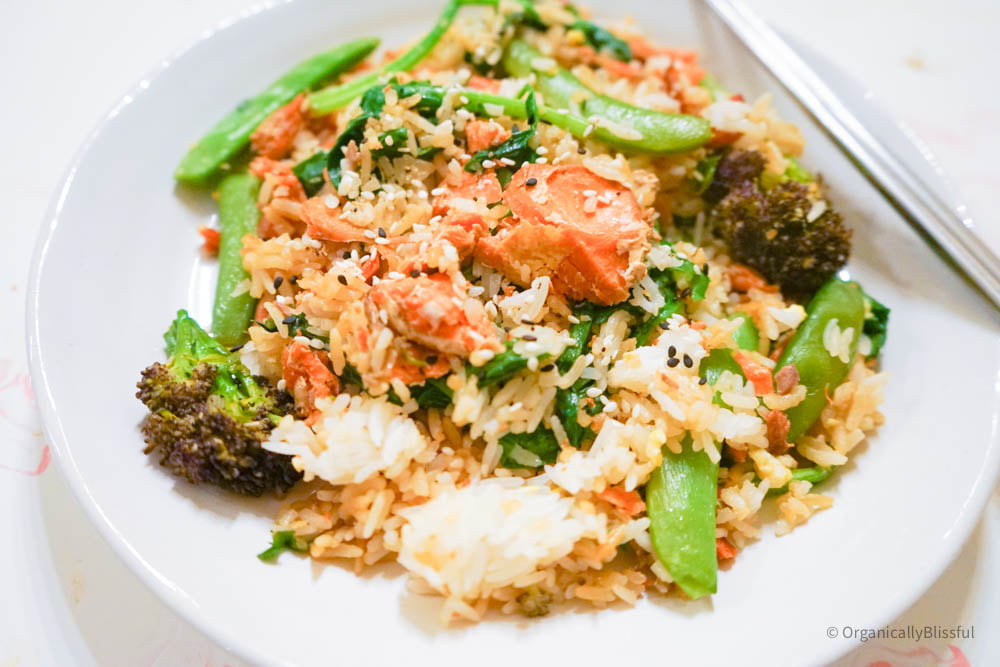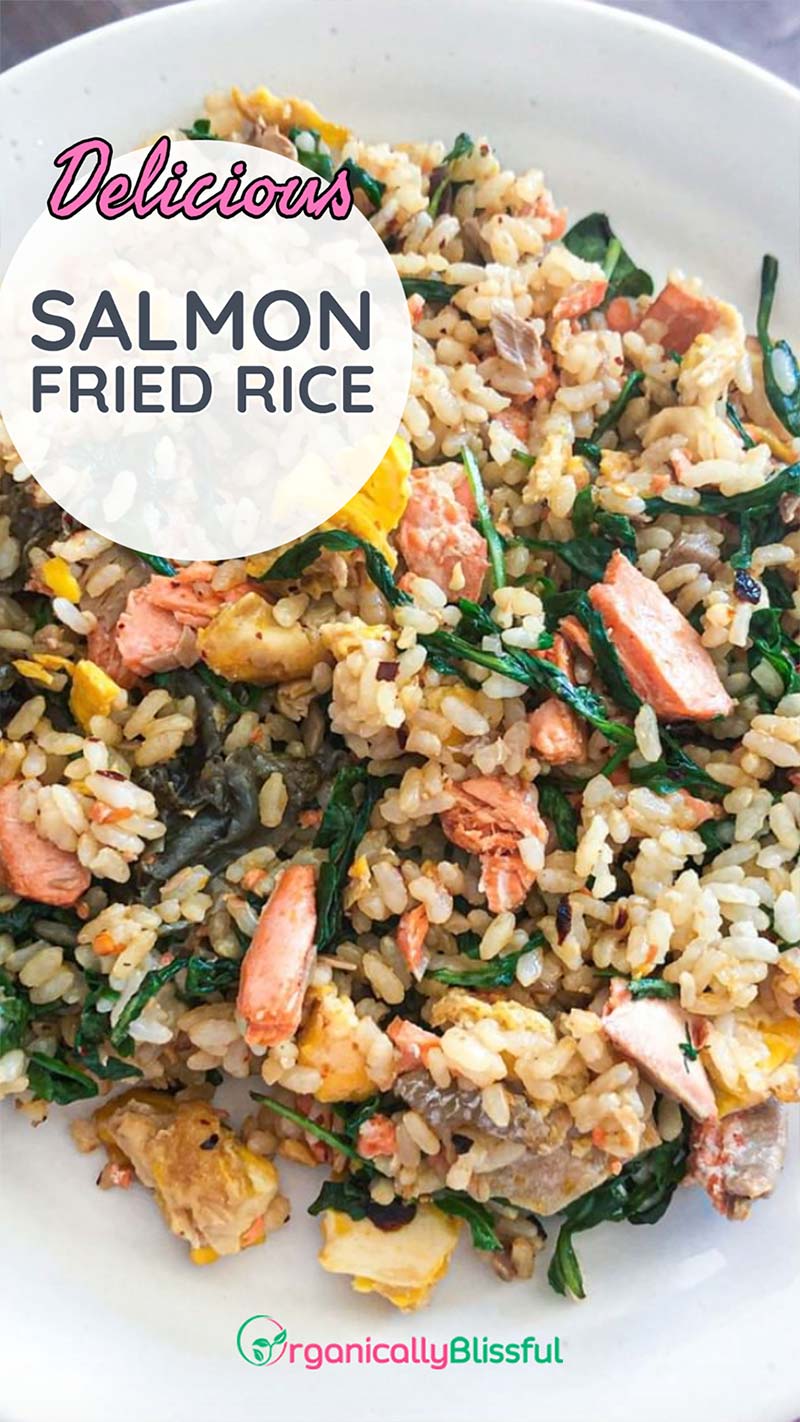Salmon fried rice is an exquisite dish that effortlessly combines the richness of succulent salmon with the comforting wholesomeness of fried rice. Prepare for a culinary adventure as you indulge in a delightful fusion of flavors and textures that will whisk your taste buds away on an exciting and unforgettable journey. So, if you're ready to embark on an epicurean adventure and savor every delectable bite, join us as we dive headfirst into the world of salmon-fried rice.
In this post, we will show you how to cook salmon fried rice in the comfort of your home. With just a handful of ingredients and a super easy preparation process, this fried rice salmon recipe effortlessly comes together for a delicious and satisfying meal.
Salmon Fried Rice Recipe
Prep Time
10 minutes
Cook Time
20 minutes
Rest Time
0 minutes
Total Time
30 minutes
Ingredients
Directions
1. Heat up the avocado oil over medium-high heat in a large skillet or wok. Add the minced garlic and sauté until it becomes fragrant.
2. Push the garlic to one side of the skillet, creating a space in the center. Gently pour the beaten eggs into the center of the skillet, allowing them to spread and form a luscious pool. Scramble the eggs until they are perfectly cooked, with a fluffy and tender texture throughout.
3. Add the chopped spinach to the skillet and cook until it wilts, stirring occasionally. This should take about 2-3 minutes.
4. Next, introduce the cooked rice into the skillet, combining it with the spinach, eggs, and garlic for a flavorful stir-fry. Use your trusty spatula to break up any clumps of rice, ensuring each grain is evenly coated with the delectable medley of flavors.
5. Drizzle the soy sauce and sesame oil over the rice mixture, ensuring every grain gets a delightful kiss of flavor. Mix thoroughly to ensure even distribution and a generous coating of each rice morsel.
6. Add the flaked salmon to the skillet and gently toss it with the rice. Exercise caution to prevent excessive flaking of the salmon while gently incorporating it into the fried rice.
7. Continue stir-frying the rice mixture for an additional 2-3 minutes, ensuring that all the ingredients are thoroughly heated and perfectly melded together.
8. Remove the skillet from the heat and refresh the dish by adding a tantalizing squeeze of fresh lemon juice. Mix it well, and then taste it to make any adjustments.
9. Transfer the salmon-fried rice to serving plates or bowls. Elevate the presentation of your dish by sprinkling a vibrant garnish of sliced green onions, adding an extra touch of freshness and a pop of color to delight the eyes.

Tips
Use cold, day-old rice: Fried rice turns out best when made with cold, day-old rice. The texture of cold rice lends itself well to stir-frying, preventing any unwanted mushiness. In the absence of leftover rice, you can opt for a simple solution: spread freshly cooked rice on a baking sheet and allow it to cool in the refrigerator for a few hours before incorporating it into the recipe. This ensures the ideal texture and consistency for your salmon fried rice.
Hot pan, quick cooking: Stir-frying requires high heat and fast cooking. Ensure your skillet or wok is heated properly before adding any ingredients. This helps to achieve the signature "wok hei," imparting a smoky and delicious flavor to the dish.
Nutritional Facts
Nutrition Facts
Servings: 4
Calories
453
% Daily Value*
Total Fat 8.5g
11%
Saturated Fat 1.7g
8%
Cholesterol 94mg
31%
Sodium 505mg
22%
Total Carbohydrate 76.4g
28%
Dietary Fiber 1.8g
7%
Total Sugars 0.7g
Protein 15.8g
Vitamin D 8mcg
39%
Calcium 62mg
5%
Iron 5mg
28%
Potassium 331mg
7%
*The % Daily Value (DV) tells you how much a nutrient in a food serving contributes to a daily diet. 2,000 calorie a day is used for general nutrition advice.
Maintain a vigilant approach by constantly stirring and tossing the ingredients in the skillet, ensuring they are in constant motion to prevent any sticking and promote even cooking throughout.
Customization and creativity: Don't be afraid to experiment and personalize the recipe. Incorporate various colorful vegetables, such as bell peppers, carrots, or frozen peas, to enhance the dish's visual appeal and texture. These additions bring an array of vibrant hues and a delightful crunch to the salmon-fried rice.
What You Need To Make This Salmon Fried Rice Recipe
Cooked Rice
It's no secret that leftover cooked rice is best when making fried rice recipes. Cooked rice is the foundation of the dish, offering a gratifying and substantial texture, a perfect canvas for soaking up many flavors. Allowing the grains to dry out slightly effectively safeguards against the risk of mushiness when the rice is stir-fried, ensuring a delightful texture throughout the dish.
Fresh Spinach
Spinach adds a vibrant green color and a touch of freshness to the fried rice. With its mild and earthy flavor, spinach harmoniously complements the other ingredients in the dish. Moreover, spinach is a nutritional powerhouse, brimming with essential nutrients such as vitamins A, C, and K, along with iron and fiber. Its inclusion adds both flavor and nutritional value to the overall dish, making it a wise and nourishing choice.
Cooked Salmon
Flaked cooked salmon adds a delightful seafood element to the fried rice. It contributes a tender, moist texture and a rich, savory flavor. Salmon has earned a well-deserved reputation for its abundance of heart-healthy omega-3 fatty acids, which offer numerous benefits.
Additionally, it boasts a generous supply of high-quality protein, making it a nutritional powerhouse. Salmon is also a natural source of vitamins and minerals, including vitamins D and B vitamins, contributing to its overall nutritional value and promoting a well-rounded diet.
Eggs
Beaten eggs are crucial in creating the classic scrambled egg element in fried rice recipes. They add a creamy texture and a mild, savory taste. Eggs are an excellent source of protein and offer important nutrients such as vitamins B12 and D, making them a nutritious component of the dish.
Soy Sauce
You can use either light soy sauce or dark soy sauce for this recipe. Dark soy sauce will add a deep color to the dish and offer more saltiness than light soy sauce.
Sesame Oil
Just a touch of sesame oil imparts a distinctive and aromatic flavor to the fried rice, elevating the overall dish to new heights. With its rich and nutty taste, sesame oil serves as a flavor enhancer. Derived from sesame seeds, this prized oil is often used as a finishing touch due to its robust flavor. Its addition brings an authentic Asian flair to the recipe, enriching it with a delightful taste that truly captures the dish's essence.
Avocado Oil
Avocado oil takes center stage as the perfect choice for stir-frying the ingredients in the skillet or wok. With its neutral flavor and high smoke point, it effortlessly withstands the heat of high-temperature cooking techniques like stir-frying, ensuring optimal results without overpowering the dish with its own taste.
Garlic
Minced garlic adds a pungent and aromatic kick to the fried rice. It imparts a robust flavor to the dish, enriching the overall taste profile and taking it to new heights of deliciousness. Garlic is widely used in many cuisines and offers potential health benefits, including potential immune-boosting and cardiovascular benefits.
Salt And Pepper
Salt and pepper play pivotal roles in seasoning the fried rice, allowing personal taste preferences to shine through. Salt enhances the flavors and accentuates the natural tastes of the ingredients, while pepper introduces a gentle heat and subtle pungency, adding an extra layer of depth to the dish.
Green Onions
Enhance the presentation of the finished dish by delicately scattering thinly sliced green onions as a flavorful garnish. These vibrant green gems impart a gentle onion taste and add fresh, colorful vibrancy to the fried rice. Green onions are widely utilized in Asian cuisine for their visual appeal, providing an inviting and visually captivating touch to the plate.
Fresh Lemon
Fresh lemon will add a bright and fragrant citrus note that can uplift the dish's overall taste and provide a refreshing twist.
Rice Wine Vinegar
Delighting the palate with its gentle sweetness and delicate tang, rice wine vinegar offers a mild flavor profile with a subtle, refreshing acidity. It effortlessly infuses dishes with a touch of brightness, enhancing the overall taste experience without overpowering the delicate balance of flavors.
Shaoxing Wine
Adding Shaoxing wine to salmon fried rice elevates the dish with a touch of sophistication. This Chinese rice wine imparts a warm, nutty aroma and a rich, savory depth to the rice, complementing the salmon's natural flavors. It enhances the overall taste profile, making the fried rice more aromatic and flavorful. If Shaoxing wine is unavailable, you can use Shaoxing wine alternatives, like Mirin.
How To Store Leftover Rice
For optimal taste and safety, leftover rice should be enjoyed within 3-4 days when stored appropriately in the refrigerator. Beyond this timeframe, the quality may diminish, and the risk of potential foodborne illness may increase. If you anticipate not being able to consume the leftovers within this period, a great alternative is to freeze them for extended storage and later enjoyment.
Frozen fried rice is a suitable option to prolong the shelf life of the leftovers. Transfer the fried rice to a freezer-safe container or freezer bag, thoroughly removing any excess air. Label the container with the date to facilitate easy reference. When stored properly, frozen fried rice can remain in good condition for up to 2-3 months, allowing you to enjoy it at your convenience.
When you're ready to indulge in the frozen fried rice leftovers, thaw them in the refrigerator overnight for optimal results. To reheat, simply warm the fried rice in a skillet or microwave until it reaches a steaming-hot state. Ensuring that the internal temperature reaches 165°F (74°C) is crucial to guarantee food safety and enjoy the dish fully.
Frequently Asked Questions (FAQ)
Can I Use Leftover Salmon In This Recipe?
Yes, using leftover cooked salmon is a great way to repurpose it into a flavorful fried rice dish. To maintain its freshness and quality, ensure the salmon is appropriately stored in the refrigerator and consumed within its designated safe consumption period.
Can I Freeze Salmon Fried Rice?
While it's possible to freeze salmon fried rice, the texture of the rice may change after thawing and reheating. The vegetables and salmon may also lose some of their freshness. If you freeze it, store it in an airtight container or freezer bag and consume it within 2-3 months for best results.
Can I Make This Dish Gluten-Free?
To create a gluten-free version of the dish, you can easily replace rice containing gluten with cauliflower rice. This substitution offers a nutritious, low-carb alternative that maintains the texture and essence of the fried rice while catering to gluten-free dietary needs.

